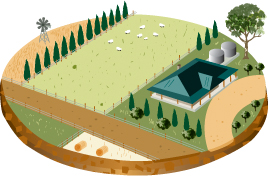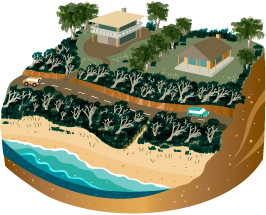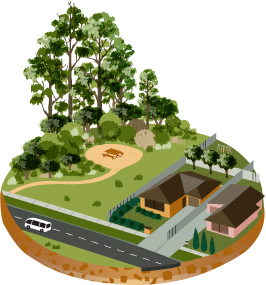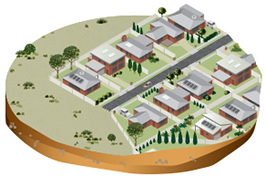Victoria is one of the most fire-prone areas in the world. Understanding your level of risk is the first step in knowing what to do before and during a fire.
Have a look at the different types of fire risk environments below and see which one you live in. By recognising and understanding your risk environment this will also help you to start preparing your property for fire and know what to do.

Close to or among grass or paddocks
Grassfires can be extremely dangerous - people can die in grassfires.
What can you expect?
- Dry and brown grass that easily catches fire.
- Grass more than 10cm tall will have a higher flame height and intensity.
- Faster burning than through forests as grass is a finer fuel.
- Radiant heat (the heat created by a fire)
- Fires that can start early in the day.
- Faster moving fires that travel up to 25 km per hour.
What to do
- Prepare your property for fire before summer starts. Create fuel breaks around your property and the assets that you want to protect – you will need to maintain these throughout summer.
- Don't get caught out in the open during a grassfire. It can get very hot and radiant heat can kill.
The safest place to be is away from the threat.
If you're caught in a grassfire move to somewhere with minimal vegetation, such as a ploughed or well-grazed paddock.
- If you're caught in a car, don't get out and run.
Turn your hazard lights on and park off the roadway away from dense bush and long grass facing towards the oncoming fire.
Before the fire approaches tightly close windows and doors, shut all vents and turn off the engine and make sure you get down below window level and cover up with woollen blankets.
Sheltering in a car is extremely dangerous and can result in serious injury or death. Always plan to leave early to avoid this situation.
- Stay informed on hot, dry, windy days by monitoring conditions outside and tuning into a local emergency broadcaster, checking emergency.vic.gov.au regularly and by downloading the VicEmergency app.
back to top ^

Close to or among dense or open bush
Risk is most extreme if you live surrounded by or near forest that is difficult to see through. However, all forest or woodland presents a bushfire risk.
What can you expect?
- Very hot fire and many embers.
- Embers such as twigs, bark and debris arriving from far away.
- Dangerous levels of radiant heat and fire intensity.
- Trees falling in high winds.
- Embers landing for a long time after the fire has passed.
- Fine fuels (the thickness of a pencil or less) that burn very quickly.
- Heavy fuels that will burn very hot for long periods of time.
- A reduction in visibility due to very thick smoke.
What to do
- You need to prepare your property for fire before summer starts.
- Decide when you will leave and where you will go on hot, dry, windy days when the risk of a fire starting is increased.
- Talk to your family and friends about when you will leave and where you will go.
- Stay informed on hot, dry, windy days by monitoring conditions outside and tuning into a local emergency broadcaster, checking emergency.vic.gov.au regularly and by downloading the VicEmergency app.
- Leaving early is the safest option to protect yourself and your family.
- If there's a fire close by, it's important to protect you and your family against radiant heat. Cover up any exposed skin because radiant heat can cause serious injury or death.
Distance is the best protection against radiant heat, so it's important to move two or more streets away from the fire.
back to top ^

Near coastal scrub
Burning scrub, heath or other coastal vegetation can create hot, dangerous bushfires. If you live by, work by or travel to the coast you are at risk. Beaches, foreshores and shallow waters may not be safe or protect you from radiant heat. Often a fire will be burning between you and the beach.
What can you expect?
- Very hot and fast-moving fires.
- Gusty ocean winds causing fire to behave erratically.
- A lot of embers.
- Fire reaching houses quickly.
- Busy, congested coastal roads.
- Radiant heat (the heat created by a fire)
What to do
- You need to prepare your property for fire before summer starts.
- Decide when you will leave and where you will go on hot, dry, windy days when the risk of a fire starting is increased.
- Stay informed on hot, dry, windy days by monitoring conditions outside and tuning into a local emergency broadcaster, checking emergency.vic.gov.au regularly and by downloading the VicEmergency app.
- Leaving early is the safest option to protect yourself and your family.
back to top ^

Where cities and towns meet the bush
You do not have to live in the country to be at risk of bushfire.
Suburban homes can burn down in bushfire, too.
What can you expect?
- Scrub, forest and grass catching fire.
- A fire in a park or reserve quickly spreading to timber fences and gardens.
- Fire spreading from house to house once houses start to burn.
- A high risk of ember attack if the house is near dense bushland environments.
- Embers falling close to or on your house starting a new fire.
- Strong winds that bring embers from far away.
What to do
- You need to prepare your property for fire before summer starts.
- Decide when you will leave and where you will go on hot, dry, windy days when the risk of a fire starting is increased.
- Stay informed on hot, dry, windy days by monitoring conditions outside and tuning into a local emergency broadcaster, checking emergency.vic.gov.au regularly and by downloading the VicEmergency app.
- Leaving early is the safest option to protect yourself and your family.
back to top ^

Where cities and towns meet grasslands
If you live in a built-up area on the edge of grassland - whether it's open grassland, parks, paddocks or reserves - you could be impacted by grassfire this summer.
What can you expect?
- Grassfires can start anywhere and spread quickly.
- Lots of smoke: Smoke makes it hard to see and can cause breathing difficulties.
Remember, smoke may lead to traffic congestion and accidents so stay off the roads.
- Radiant heat (the heat created by a fire)
What to do
- If you live in an urban area near grasslands, walk at least two streets back if a fire starts. If you live two or three streets away from grassland and a grassfire starts, stay where you are. Grassfires are unlikely to spread into built up areas.
It is safest to do this by walking to keep roads clear for emergency services and help reduce road accidents.
- Act early, even if you haven't received a warning.
- If you live two or more streets away from grassland you should stay where you are.
Grassfire is unlikely to spread into built up areas.
Stay indoors and keep all windows and doors closed, place towels or blankets around the bottom of doors and window sills and don't use your air conditioner.
- Reduce your risk. Mow your grass and remove anything flammable - firewood, rubbish, weeds – from around your home and fence line.
- Stay informed on hot, dry, windy days by monitoring conditions outside and tuning into a local emergency broadcaster, checking emergency.vic.gov.au regularly and by downloading the VicEmergency app.
back to top ^
Page last updated: Thursday, 21 December 2023 4:25:38 PM